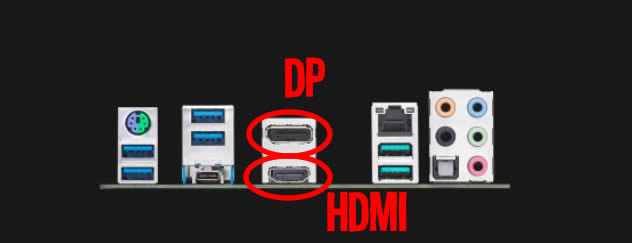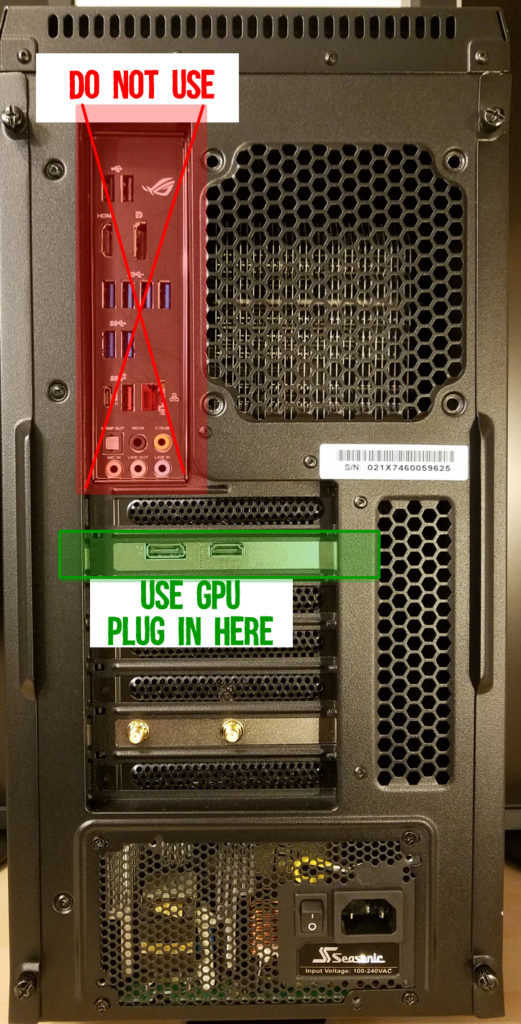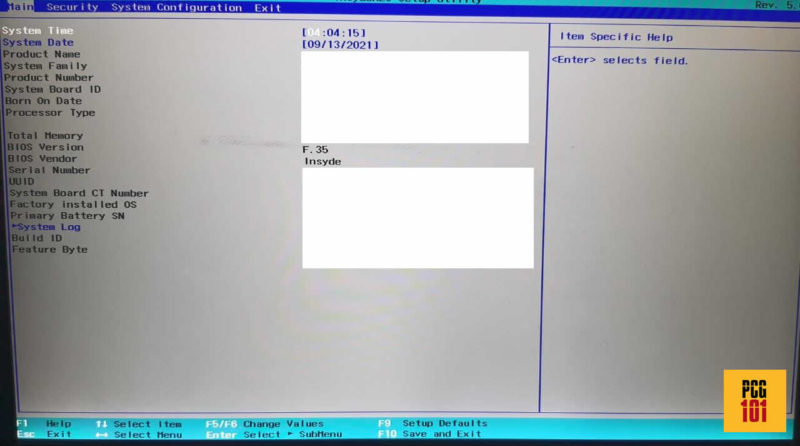So you have just purchased a new monitor for your shiny new PC, but finding video output ports on both the motherboard and the graphics card has confused you. Should you connect the monitor to GPU or motherboard?
The simple answer to the query is that you must connect your monitor to the GPU (dedicated).
Why? Well, for starters, in most cases, the motherboard’s video output port gets disabled when you have a dedicated graphics card installed.
Secondly, even if you manage to make the motherboard’s video output ports work despite having a dedicated graphics card (through BIOS or other methods), the monitor connected to the motherboard will have a poor performance since it will utilize the integrated graphics card which is far weaker compared to dedicated graphics cards.
So in the following text, I will detail where you should connect your monitor, what to do if you have dual monitors, and why motherboard video output ports should not be used when you have a dedicated GPU installed.
First, let’s refresh our understanding of integrated GPUs (iGPU) and dedicated GPUs.
TABLE OF CONTENTS
How Motherboard Video Output Ports Get Powered
For starters, know that motherboards do not have onboard graphics processing capability.
The video output ports on a motherboard get powered through the integrated graphics card within the CPUs.

No Integrated Graphics Card = No Video Output From Motherboard
If your PC does not have a CPU with an integrated graphics card, then your motherboard’s video output ports will not work.
Intel F series CPUs, like the Intel Core i7-11700F, lack an integrated graphics card.
As far as AMD goes, only the G series CPUs, such as the AMD Ryzen 7 5700G, offer an iGPU. Those with no suffix, ‘x’ suffix, or the ‘xt’ suffix do not feature an iGPU.
Hence, if you have a CPU that lacks an integrated graphics card, you can tell that your monitor will NOT display anything if plugged into the motherboard.
So, in this case, you would have no option but to use the dedicated graphics card for your monitor.
But there are a few more important reasons why the dedicated graphics card should be used for the monitor, which I explain below.
So Should You Connect the Monitor to the Motherboard?
No, you should not. There are three main reasons for this:
1. Integrated Graphics Card Get Disabled When You Have a Dedicated Graphics Card Installed
In most cases on desktop PCs, if your CPU does have an integrated graphics card, it gets disabled when you have a working, dedicated graphics card plugged in.
This is done automatically through the BIOS.
Hence plugging in the monitor in the motherboard may be futile.
2. More Importantly: The Monitor Connected to Motherboard Would Have Horrible Performance
Secondly, and more importantly, even if you are successful in connecting a monitor to the motherboard and, for some reason, the BIOS does not automatically disable the iGPU, it is still a terrible idea.
As explained earlier, the video output ports on the motherboard make use of the CPU’s integrated graphics card for graphics/visual processing.
An iGPU, in most cases, is far less capable than even the weakest dedicated graphics cards. Hence, your overall experience, particularly when gaming, would be horrible.
In other words, all tasks, including the games you play, will be processed through the integrated graphics card, NOT the dedicated graphics card if you have a monitor connected to the motherboard.
So basically, your dedicated graphics card would be sitting idle while your iGPU would strive hard to give you a horrible performance.
3. The Dedicated Graphics Card is There For a Reason. Please make Use of It
And finally, you have bought a dedicated graphics card for improving the graphics quality for work or gaming purposes.
Hence, connecting your monitor to the dedicated graphics card is only wise.

Plug your monitor into the GPU for the best visual performance and frames per second.
Suppose you plug your monitor into a motherboard. In that case, it will utilize the integrated graphics card, if your CPU has one, instead of the dedicated GPU, resulting in horrible visual performance and frames per second.
If your CPU has no iGPU, you will get no video from the motherboard.
Can You Use Both GPU and Motherboard For Multiple Monitors At The Same Time?
Those who want to build a dual or multiple monitor setup often ask this question.
If your dedicated GPU does not have sufficient video output ports, you may wonder whether you can connect your second monitor to the spare ports on the motherboard.
I have written a comprehensive article on how to Use Motherboard HDMI with Graphics Card.
But the short and straightforward is yes, you can IF your BIOS allows you to do so.
Yes, If Your BIOS Has the Option
Generally, the iGPU and, in turn, the motherboard video ports get disabled when you have a dedicated GPU installed.
However, if your BIOS has a setting that allows you to “Enable Multi-GPU Support” or something like “Enable iGPU,” etc., you can use your motherboard video output ports and the graphics card.
Unfortunately, in many cases, the BIOS versions are not comprehensive enough to provide you with this functionality.

Many BIOS versions are deliberately designed to have this option absent so that users do not tamper around much.
The Second Monitor Connected to Motherboard will have Abysmal Performance
Again, even if you successfully enable the motherboard video ports, you will have the same problem for your dual or multi-monitor setup.
Suppose you have one monitor connected to the dedicated GPU and the other connected to the motherboard. In that case, the one connected to the dedicated GPU will perform excellently, while the other will suffer in quality and experience frame drops when gaming.
Also Read: Does Dual Monitor Use More GPU?
Final Words
The simple answer to the question “should you connect the monitor to GPU or motherboard?” is GPU. Plug your monitor into the dedicated graphics card and disregard the spare ports on the motherboard.
FREQUENTLY ASKED QUESTIONS
1. Can I connect a monitor to both the GPU and the motherboard simultaneously, and what are the benefits of doing so?
Yes, you can connect a monitor to both the GPU and the motherboard simultaneously. This is called multi-display or hybrid graphics.
The main benefit of using this setup is that it allows you to use both the integrated graphics and the dedicated graphics simultaneously, which can be useful in situations where you need to run multiple displays or when you need to use different graphics for different tasks.
However, it’s important to note that this setup can cause compatibility issues, and some systems may not support it.
2. Can I use multiple monitors with my GPU and/or motherboard, and what are the limitations and requirements?
Yes, you can use multiple monitors with your GPU and/or motherboard.
The number of monitors you can use depends on your system’s graphics card and the number of available ports.
Most modern graphics cards support multiple displays, with some supporting up to six displays simultaneously.
However, some older graphics cards may only support a single display.
In addition to the number of ports, the type of cable and the resolution of the monitors can also affect the number of displays you can connect.
3. Can I switch between using my GPU and my motherboard for my monitor, and what is the process for doing so?
Yes, you can switch between using your GPU and your motherboard for your monitor.
The process for doing so varies depending on your system and your operating system.
In general, you can switch between graphics by changing the display settings in your operating system.
For example, in Windows 10, you can right-click on the desktop and select “Display Settings,” then select the display you want to change and choose the graphics adapter you want to use.
In some cases, you may need to adjust the BIOS settings to switch between graphics.
It’s important to note that switching between graphics can cause compatibility issues and may require a system restart.
